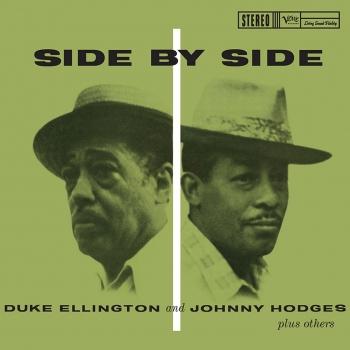
Back To Back (Remastered) Duke Ellington & Johnny Hodges
Album Info
Album Veröffentlichung:
1959
HRA-Veröffentlichung:
28.02.2014
Label: Universal / Verve
Genre: Jazz
Subgenre: Mainstream Jazz
Interpret: Duke Ellington & Johnny Hodges
Das Album enthält Albumcover
Entschuldigen Sie bitte!
Sehr geehrter HIGHRESAUDIO Besucher,
leider kann das Album zurzeit aufgrund von Länder- und Lizenzbeschränkungen nicht gekauft werden oder uns liegt der offizielle Veröffentlichungstermin für Ihr Land noch nicht vor. Wir aktualisieren unsere Veröffentlichungstermine ein- bis zweimal die Woche. Bitte schauen Sie ab und zu mal wieder rein.
Wir empfehlen Ihnen das Album auf Ihre Merkliste zu setzen.
Wir bedanken uns für Ihr Verständnis und Ihre Geduld.
Ihr, HIGHRESAUDIO
- 1 Wabash Blues 06:24
- 2 Basin Street Blues 08:01
- 3 Beale Street Blues 07:35
- 4 Weary Blues 06:54
- 5 St. Louis Blues 05:47
- 6 Loveless Love 07:09
- 7 Royal Garden Blues 05:25
Info zu Back To Back (Remastered)
Mehrmals im Verlauf seiner Karriere hatte der Star-Solo-Altsaxophonist Johnny Hodges sich selbständig gemacht, nur um jedes Mal wieder zu Duke Ellingtons Band zurückzukehren. Es scheint eine konstante Spannung zwischen den Beiden bestanden zu haben, obwohl das zum Zeitpunkt dieser Aufnahme ein alter Hut war. Im Begleittext untersucht der Kritiker Michael Ullman diese komplexe Beziehung und vermutet, dass die Blues-Klassiker, die für dieses Programm ausgewählt wurden, sozusagen neutrales Gebiet waren. Sowohl Ellingtons einzigartiges Klavierspiel konnte in den Vordergrund treten, aber auch Hodges unwiderstehliche Sinnlichkeit hatte freies Spiel. Dies ist eine der besten Aufnahmen mit kleiner Besetzung, die Ellington je gemacht hat - eine entspannte, perfekt ausgeglichene musikalische Zusammenstellung, die wahrlich den Blues swingen lässt.
Duke Ellington, Klavier
Johnny Hodges, Alto Saxophone
Les Spann, Gitarre
Harry 'Sweets' Edison, Trumpete
Al Hall, Kontrabass (tracks 1, 4)
Sam Jones, Kontrabass
Jo Jones, Schlagzeug
Recorded at Columbia Studios, New York, New York, February 20, 1959
Produced by Norman Granz
Digitally remastered
Johnny Hodges - Alto Saxophone
In one sense or another, Johnny Hodges was always on his own — even on the Ellington bandstand, where he began and became best known. He joined Ellington early in life, at twenty in 1928, and he died a member of the Duke Ellington Orchestra, suffering a heart attack in a dentist’s chair shortly after recording part of his lifelong boss’s New Orleans Suite in 1970. As a result, his sound, or his two principal sounds — the lusty warmth of his ballad readings and the offhand lilt of his uptempo improvisations — are inevitably associated with Ellington. Yet Hodges’s voice came entirely from within; as Ellington put it, he "is a consummate original." Indeed, Hodges is now widely acknowledged as one of the most individualistic interpretive voices in all jazz.
As a solo artist away from Ellington, Hodges had three mini-careers during his tenure with Norman Granz and the labels he launched: independent bandleader, after he resigned from the Ellington organization, 1951–55; soloist, mostly leading ensembles of Ellington orchestra members after he reunited with Duke, from 1956–61; and would-be jazz-pop star, working with the hit-oriented producer Creed Taylor, 1961–70.
Duke Ellington - Pianist
The child of loving and relatively well-to-do African-American parents, Edward Kennedy "Duke" Ellington was born on April 29, 1899, in Washington, D.C. — not only the capital of the United States but, at that time, home to the largest and best-educated black population in the country. As he became a teenaged bandleader, he learned to appreciate the unique aspects of every musician in his group, and he was later able to reconcile these differences and utilize them in an innovative and completely democratic way. He inspired confidence in his musicians. After building a successful dance band business in Washington, he moved to New York City in 1923.
The Duke cultivated exotic sounds in his orchestra: an emphasis on contrast between the low- and high-pitched instruments, a prominent use of minor keys and blues tonalities, a style he called jungle music, and unusual effects drawn out or encouraged from his instrumentalists and vocalists.
By the late 1920s, Ellington’s musicians had all developed into distinctive soloists. Among the great players who worked with Ellington over the years were saxophonists Johnny Hodges, Harry Carney, and Ben Webster; clarinetists Barney Bigard and Jimmy Hamilton; trumpeters Bubber Miley, Cootie Williams, Rex Stewart, and Ray Nance; trombonists Joe "Tricky Sam" Nanton and Lawrence Brown; bassist Jimmy Blanton; and drummer Sam Woodyard. That array of talent remains awe-inspiring and will continue to influence future generations of jazz musicians. The maestro also easily participated with, and challenged, such younger innovators of the 1960s as bassist Charles Mingus and saxophonist John Coltrane.
Perhaps more consequential was "Mood Indigo" which became one of the first pieces written by a jazz composer to be accepted by the public as a popular song. From this point on, Ellington developed into a major contributor to the American popular-song repertoire, writing such other hit tunes as "In a Sentimental Mood," "Prelude to a Kiss," "Sophisticated Lady," "Solitude," and "Satin Doll." However, the piece most people associate with Duke Ellington, "Take the ‘A’ Train," was written by pianist-composer Billy Strayhorn, who joined Ellington in 1939 and became his closest associate. Saddened but not defeated by Strayhorn’s death in 1967, the Duke continued to compose, play, and tour with his world-famous orchestra until his own death on May 24, 1974.
Of the first generation of jazz musicians, Ellington and Louis Armstrong were the most responsible for moving jazz from a form of entertainment to a form of artistic expression. Over six decades, from the 1920s to the 1970s, Ellington continually expanded his scope and range of expression, for he was somewhat of an anomaly in the jazz world: a composer. (Andrew Homzy /Excerpted from Duke Ellington’s Finest Hour)
Dieses Album enthält kein Booklet













